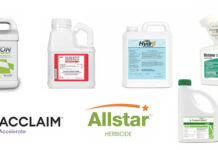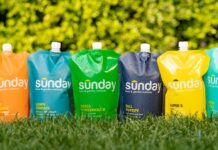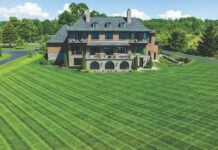Broadleaf weed control is an important aspect to every turf care program. Weeds are the main reason that homeowners hire lawn care professionals. Fertilization and weed control are the cornerstones of lawn care.
There are a lot of factors that go into a good broadleaf weed control program. Although it might be possible to list 10 or 15 different factors that influence broadleaf weed control, I have highlighted the five most important tips to enhancing your broadleaf weed control program.
1. Weed life cycles

The first tip to enhancing weed control is to make sure that you understand and correctly identify the life cycle of the broadleaf weeds that you are having trouble with. Weeds are divided into groups by their life cycles: annuals, biennials and perennials.
Annuals: Annuals germinate from seed, grow, mature and die in less than 12 months. Annuals may be further classified as winter or summer annuals.
Winter annuals germinate in the fall, overwinter as plants, mature in the spring, flower, set seed and then die during the summer. Annual bluegrass is our most common winter annual grassy weed in turf. Henbit, purple deadnettle and common chickweed are examples of winter annual broadleaves.
Read more: 4 Winter Annual Weeds You Need To Know
Summer annuals germinate in spring and grow actively during the summer, flower, set seed in late summer and die in the fall. Crabgrass and goosegrass are summer annual grasses. Prostrate spurge and purslane are examples of summer annual broadleaf weeds.
Biennials: Biennials reproduce from seed and complete their life cycle in two years. Biennials form rosettes and store food in their fleshy roots the first year, and then flower the second year. There are few biennial weeds in turf: wild carrot, musk thistle, and bull thistle are the most common biennial turf weeds in the Midwest.
Perennials: Perennial weeds live more than two years. They may reproduce from seed or from vegetative structures such as roots, rhizomes, stolons, tubers, corms or bulbs. This ability to reproduce vegetatively makes perennials more difficult to control. Some perennials (such as dandelion, curly dock and wild garlic) actively grow during cool weather, while others (such as dallisgrass and yellow nutsedge) grow rapidly during the summer.
Perennials may be further classified as simple perennials or creeping perennials.
Simple perennials (such as common plantain and dandelion) overwinter by means of a vegetative structure (such as a perennial root with a crown), but reproduce almost entirely by seed.
Creeping perennials can both overwinter and produce new, independent plants from vegetative reproductive structures. Vegetative reproductive structures include stolons (creeping woodsorrel), rhizomes (wild violet), tubers (nutsedge), corms (spring beauty) and bulbs (wild garlic). Most perennials can also reproduce from seeds.
2. Timing

The optimum time to control weeds depends on the type and life cycle of the weed and, in some cases, the specific weed and specific herbicide, so the optimum time to control weeds is a complex answer. Regardless of the timing and weed, it is important to select herbicides with a high efficacy for the specific weeds you are targeting (See Tip #4 below).
In the Midwest, perennial broadleaf weeds are best controlled with postemergence herbicides in the fall (Sept. 1 to Nov. 15). October applications are optimal. This window can be extended longer if the end of the fall is mild or if the turf is located farther south. Herbicides on perennial broadleaf weeds are more effective in fall because plants are more likely to translocate (move downward) herbicides into root and stem tissues as days get shorter and temperatures cool. Typically, this will occur near or following the first frosts.
Previous research in Nebraska has demonstrated that 2,4-D and dicamba are far more effective at controlling dandelions and Canada thistle when applied one to 10 days after the first fall frost than when applied five to 11 days before the frost. Other work at Michigan State University found that “good dandelion control can result from herbicides applied through late October, even when the plants are not actively growing.” More recently, Purdue researchers found that November applications of most herbicides resulted in ground ivy control similar to earlier (September and October) applications.
Spring applications will also control perennial broadleaf weeds, especially if an herbicide is selected that has good activity on the weed and if the correct formulation is chosen (See Tip #3 below).
Winter annual broadleaves can be controlled at the same fall timing as perennial broadleaves. Fall timings are best for winter annuals because they are small after just germinating and herbicides translocate (move inside the plant) well in the fall. Spring control of winter annual broadleaves is more difficult because the weeds are larger and are less likely to translocate herbicide. Additionally, controlling winter annuals in the spring is not typically necessary as these weeds will complete their life cycle and naturally die at the end of the spring.
Summer annual broadleaves and summer annual grasses are best controlled with preemergence herbicides applied in the spring before they germinate. They can also be controlled with postemergence herbicides in early summer when the temperatures are cooler and before the weeds become too large and before they produce seed.
3. Formulation and chemistry

Synthetic auxin herbicides (also known as growth regulating herbicides), which include 2,4-D, 2,4-DP, dicamba, triclopyr and MCPA, are commonly formulated in two distinct forms: amine salts and esters. This formulation affects the performance of these herbicides and when (what time of year) you will want to use them in your weed control program.
Amine formulations are generally less volatile than esters and safer to use when applying near sensitive plants, such as ornamental landscapes and gardens.
Ester formulations have a higher vapor pressure and generally a higher volatilization potential (with the exception of certain formulations labeled as “low volatile”).
Research has documented that fall applications with amine or ester formulations of 2,4-D provide optimum broadleaf weed control. However, spring applications are sometimes needed in weedy locations or when you miss an opportunity to make a fall application.
Purdue University research demonstrated that during cooler spring months (April), ester formulations are more effective for broadleaf weed control because they more readily penetrate the leaf cuticle. As temperatures in the spring warm, turf managers should switch to amine formulations because they work better during warmer temperatures in May and early summer. What’s more, amine formulations are less volatile than ester formulations, making them safer to use around landscape plantings.
To help track weather conditions and the appropriate time to use amine and ester formulations, visit Michigan State University Extension’s GDD Tracker.
4. Herbicide selection matters

While all the factors above are important, herbicide selection may be the most important factor. Most herbicides work really well on a certain number or set of broadleaf weeds, but they don’t work well on all broadleaf weeds. For example, 2,4-D is a common ingredient in many broadleaf herbicides. While 2,4-D is great for controlling dandelion, plantains, curly dock and many other broadleaf weeds, it doesn’t control white clover. However, dicamba controls white clover well. For this reason, many broadleaf herbicides are premixed together in formulation to help you control a broad-spectrum of weeds with your applications.
Herbicides on the market containing phenoxy herbicides, such as 2,4-D, mecoprop (MCPP), 2,4-DP (dichlorprop), MCPA and benzoic acid dicamba, offer broadleaf weed control.
There are a number of herbicides on the market that contain phenoxy herbicides such as 2,4-D, mecoprop (MCPP), 2,4-DP (dichlorprop) and MCPA, as well as the benzoic acid dicamba for use in broadleaf weed control. Phenoxy herbicides specifically work to control broadleaf weeds. These ingredients make up the majority of what are commonly referred to as “three-way” herbicides with 2,4-D, MCPP and dicamba serving as the core three ingredients.
The reason that so many products on the market contain this combination of ingredients is because they’re effective to use on both cool- and warm-season grasses; exhibit excellent turf safety (except during green-up of warm-season turf); they’re low cost; and they provide consistent control of common broadleaf weeds when applied at the right time.
However, some other tough broadleaf weeds such as ground ivy, wild violet, India mock strawberry, thistles, yellow woodsorrel, corn speedwell and lespedeza are often not completely controlled with three-way herbicides. And, that’s in spite of many of these tough-to-control broadleaf weeds being listed on the three-way herbicide label. The fact is that they may provide control in some situations, but often these tough broadleaves require the use of a different set of ingredients to improve control. Ingredients for tough broadleaf weeds are discussed in a in “The Right Products for Tackling Tough Broadleaf Weeds“. If you are struggling with tough broadleaf weeds like violet, ground ivy, yellow woodsorrel, lespedeza or thistles, that article should help. Triclopyr, fluroxypyr, metsulfuron and many other herbicides work well to control these tough broadleaf weeds depending on your turf species.
Check your state’s extension recommendations for selecting herbicides for controlling the weeds you find most problematic. Many of these publications, including the Turfgrass Weed Control for Professionals publication from my program, contain tables to help you select the best herbicide for each weed or narratives for each weed species to help you select the right herbicide.
5. Spray tank water quality

Does the pH and hardness of your spray water influence weed control? Yes, but exactly how much depends and the weed and the herbicide chemistry. The quality of the water in herbicide applications is often overlooked. Research clearly shows that the quality of water used for spraying can affect how herbicides perform, especially glyphosate. Preliminary data at Purdue suggests that some broadleaf weeds like dandelion are not controlled as well by 2,4-D when the water is hard from too much calcium. However, this same preliminary research found that 2,4-D can be used effectively to control dandelions when a water conditioner like ammonium sulfate is used to mitigate the influence of the hard water. A publication titled “The Impact of Water Quality on Pesticide Performance” (Purdue Extension publication PPP-86) describes how to test your water quality for better performance of your herbicides. It’s available as a free download from the Education Store.
In summary, if you understand the life cycle of these weeds and the best time to control them, if you select the right herbicide and formulation, and you have good water quality in your spray tank, you’ll be very successful at controlling your broadleaf weeds.
Dr. Aaron Patton is associate professor of agronomy and turfgrass extension specialist at Purdue University. More information about weed control for turfgrass professionals written by Dr. Patton is available in a 96-page Purdue University Extension publication AY-336, Turfgrass Weed Control for Professionals, available from the Purdue Extension Education Store as electronic ($10) or hard copy ($12). Contact him at ajpatton@purdue.edu.











![[VIDEO] Dickies®: Discover Workwear That’s Anything But Uniform](https://turfmagazine.com/wp-content/uploads/2023/06/1647663814-4b1a2a7742790a9b1e97a3b963477850192e1d6a9dfba9b07214a77bae25d6e3-d-218x150.jpg)






























![[VIDEO] Dickies®: Discover Workwear That’s Anything But Uniform](https://turfmagazine.com/wp-content/uploads/2023/06/1647663814-4b1a2a7742790a9b1e97a3b963477850192e1d6a9dfba9b07214a77bae25d6e3-d-324x160.jpg)
What about regions such as mine, which no longer allow herbicide use?
Shit out of luck, unless you want to spray around a pool salt in the winter (acts like glyophosphate – roundup).
You talk about water quality but what about sprayer droplet size and the use of surfactants?